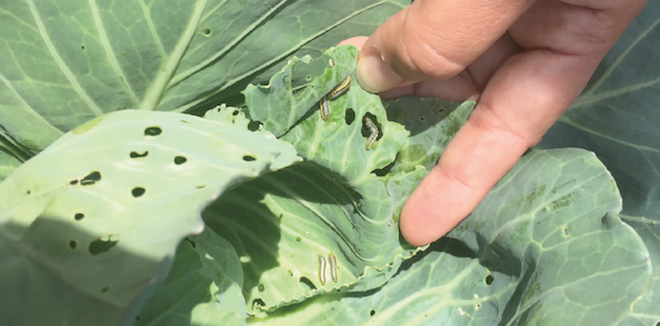
Apr 6, 2020Vestaron revs up commercial production of Spear products
Daniel Peck joined Vestaron Corp. a year ago in what became a timely indoctrination into the fledgling company’s mission to improve the safety, efficacy and sustainability of crop protection through displacement of chemical pesticides with biological peptides.
Peck, a Ph.D. who earned his doctorate in entomology from Cornell University, is a field development biologist who brought to Vestaron 25 years of experience in insect pest management.
 Vestaron, with headquarters in Durham, North Carolina, registered and released two formulations of its Spear bioinsecticide in the U.S. The first, Spear-T, was approved by the U.S. EPA in 2018. It is a concentrated liquid formulation designed for contact activity against a broad range of insect and mite pests in the greenhouse.
Vestaron, with headquarters in Durham, North Carolina, registered and released two formulations of its Spear bioinsecticide in the U.S. The first, Spear-T, was approved by the U.S. EPA in 2018. It is a concentrated liquid formulation designed for contact activity against a broad range of insect and mite pests in the greenhouse.
The second, Spear-Lep, was approved in 2019. This product largely targets lepidopteran (caterpillar) pests in outdoor and indoor crops where a reduced rate of Spear is applied with a synergist (Bt) to achieve efficacy through ingestion.
With the recent Insecticide Resistance Action Committee (IRAC) approval of a novel mode of action for the Spear brand family of products, Vestaron believes it is building a commercial phase onto its research and development foundation.
“We’re the most recent one to appear and be approved by the IRAC committee,” Peck said. “The last major approval for modes of action was maybe 10 years ago with the diamides. New modes of action are few and far between. It’s exiting for us as a company to know that in two or three years we may have products out there with two additional modes of action with maybe IRAC groups 33 and 34 on the horizon.
“That’s one of the reasons it’s so exciting to be working with this company,” Peck said. “As an entomologist, your opportunity to work with a new IRAC code are not too common.
“Back in the day, I worked with the diamides when they were coming out in turf grass,” he said. “That was a long time ago. Some of the best ways to prospect for new modes of action are from the biologicals. Synthetics are just so costly. You end up with something with failures in the registration process. With a biological, you can get through the registration process a lot more cheaply and more quickly when compared to a synthetic.
“The company been around 10-12 years, originally starting as an R&D company which has very recently turned into full commercialization when we found out certain things about this line of ingredients and how willing investors were to throw in with us because we’re a venture-backed company,” Peck said.
“The whole design about this is we use biologically active peptides in plant production products. Our first peptide is an insecticide that we have in two products, but we also have a pipeline of other peptides as well.”

Peck said the origin of this peptide was some research that was done with some biologically active compounds in spider venom. Venom happens to be a lucrative place to look for biologically active compounds.
“In the process of developing these peptides, we are able to pre-select them to make sure there is no mammalian or vertebrate toxicity, weed out ones that may have pollinator activity and we can end up with an ingredient and product that has a really good safety profile. The first peptide that we have is Spear. It’s sold in two products, Spear-T and Spear-Lep.
“The way this peptide works is it’s a very large molecule. It’s about 18 times larger than a micropred. Bt (Bacillus thuringiensis) is about 30 times larger than this.”
The first commericially available product available was Spear-T, which is largely for greenhouse use.
“We use a topical dose of the Spear peptide that diffuses through the spiracles and thereby able to reach the active sites in the insects,” Peck said. “The other way to get this active molecule to the active sites is to get it in via ingestion. That’s really opened up a whole new world because when we discovered that, in combination with a fairly low dose of Bt, in this case a lepidopteran active Bt caterpillar active, disrupts the mid-gut enough so that this peptide, when it’s ingested at the same time, it can hit those target sites.
“This is actually a synergy,” he said. “Relatively low rates of both of them perform a lot better than if you would just add them up on how they would kill alone. So that synergy allows lower use of rates outdoors, and a low level rate of the Bt.
Peck said the peptides are “very target-site specific. We are classified by the EPA as a biopesticide, but unlike some of the biochemical and bicromial insecticides that are out there, we have very targeted site specificity.”
In November 2018, IRAC, which sets the different modes of action, determined that Spear was going to be introduced and classified as a new IRAC group.
“This means that this product can now be used to help with insecticide resistance management because three’s not an insect out there that’s resistant to it, and it is cross-resistant to any other active ingredient that we have out there. That was when the company shifted over and moved to full commercialization. The next peptide in our pipeline we will be developing will have another IRAC group.
“What we’re seeing now is the development of a whole new kind of chemistry that is not a synthetic chemical,” Peck said. “It’s a modified biologically based component that has a very good safety profile. We like to advertise that we have the safety of the biologicals but the performance of the synthetics.”
Some pest targets
“As we move toward full commercialization we’re realizing there are some gaps in what we know about it and we’re doing a lot of field development last year and this year,” Peck said. “In the field vegetable area, we’ve gotten a lot of data that’s proven (Spear-Lep’s) performance in various systems such as diamondback moths in brassicas and collards, and other crucifers against any other kinds of lepidopteran pests out there. It’s probably very broad spectrum and can impact about every kind of lepidopteran species that might be out there if you can get good coverage of the plant surface so the pest will ingest it.”
Peck said the product “also has a very good safety profile for natural enemies because it’s only going to impact lepidopteran species’. It won’t impact parasitoids or lady bird beetles or lace wings or pollinators. It’s also a product that can be used if you’re worried about impacting natural enemies out there.”
“If you’re worried about resistance management – and you’re going to rotate your modes of action – this would be a product to incorporate. It’s a product that also has no residues It’s MRL (maximum residue level) exempt so the residues are not relevant so it can be sprayed right up until the time of harvest. It’s got all of the things that you’re familiar with as far as the safety features of a biological but has the versatility of a conventional.
“It’s pretty amazing what has happened in the last three years and where it’s at now,” Peck said. “It’s really something.”
“We see it improving our sustainability and land stewardship and such,” Peck said. “We know that this kind of active ingredient is really going to improve sustainable crop protection. Sustainability in that sense means putting into practice pest management techniques and approaches that are going to reduce the negative consequences of pesticide use, environmental and social economics. One way to do that is to protect from the development of pesticide resistance.”
Peck said Spear-Lep can be put into the mix and the application rotation “so this product also can increase the lifespan of some other conventional products that are very important tools. It’s a product and an approach that will help other active ingredients, as well. The other sustainability part about this is the safety profile is so good that it will just reduce the risk to humans, non-targets and to the environment.”
— Gary Pullano, VGN managing editor
Multiple crop pests targeted with Vestaron’s Spear-Lep product
















